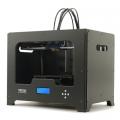Results 1 to 10 of 11
Thread: Warpping direction
-
02-01-2016, 03:21 AM #1Student

- Join Date
- Feb 2016
- Posts
- 2
Warpping direction
Good morning!
I have been working lately with additive manufacturing and I have faced a question that I couldn't answer reading on internet.
I know that warpping is due to a difference of temperature between the bed and the new layer or between new layers. But why does plastic warp edges upwards?
I mean:

and

From what I know, cold parts (bed) should contract and hot (new layer) expand so if we look at the piece it should be contracted in the bottom part, none in the neutral axis and expand on the upper part as it is hotter.
I thought it could be related to he infill but, as it happens in the photos I posted, the parts are flat so no much infill.
What am I missing to understand this?Last edited by XprinterX; 02-01-2016 at 03:29 AM.
-
02-01-2016, 04:56 AM #2
No, parts will curl upwards. As hot, upper layers cool down they will pull the cool, lower layers upwards.
-
02-01-2016, 07:15 AM #3
Layer separation is combated by printing slower and/or warmer (new layer doesn't have the time/temp to bond to previous layer).
Corner lift is combated by adding a brim, using a binder on the build plate, heating the build plate (first layer doesn't bond to the build plate strongly enough to withstand force from higher layers contracting).
Heating your chamber will help both to some degree.
-
02-01-2016, 11:36 PM #4
One thing I've also found is how your print is designed will affect warping/separation. Hard corners tend to warp and separate more than rounded corners. If it is not necessary to have a hard 90' corner, then design in a rounded edge. Long edges or rounded corners have more material near them to help bond with other layers/bed, while hard points or corners have less material, and the more/less material also affects cooling. If a round corner isn't possible, then adding a single layer brim to be trimmed off later can help. Example: Adding a small circle of material at each corner.
Obviously other people's design's may not account for this, or your design is dependant upon a hard corner there, but avoid them whenever possible. I've also found (and most engineers will know this) that a hard corner transfers loads for less effectively than a rounded one, so consider this for interior corners too. Whenever I'm making servo sleds for racing boats, I round as many corners as I can. Through both stress simulators and real life experience I've found vastly improved performance this way.
-
02-02-2016, 01:49 AM #5
A heated chamber is the number one solution for this. I print large ABS items with no warping.
-
02-02-2016, 03:17 AM #6Student

- Join Date
- Feb 2016
- Posts
- 2
Thank you for your knowledge!
I think I get the point. I was wrong as I was thinking about an expansion issue (metals) and a contraction issue (plastics) was the same thing. But this gave me another question:
If the layers tend to curve upwards and they don´t because of the previous / next layer bounding. Does this mean that the objects are facing and "additive" internal stress with each layer? Because right now what I am picturing is:
You print one layer. Due to the glass transition propierties, the shrink quicker at the beginning than later.
The next layer is printed a little bit on the air (what the previous layer shrunk) and tries to contract generating a compressive effort and a torque.
Repeating this until the last layer you will get an object with a lot of interal stress isnt it?
Please correct me if I am wrong.
-
02-02-2016, 05:52 AM #7
No, the shrinking is in the X/Y; any Z shrinking in negligible, since the layer's Z distance is minimal compared to the X/Y distances.
It lifts up from the previous layer after being deposited because it cools more than the lower one. Stress is greatest on the longest distances (diagonals).
Once the entire shape cools, the differential which leads to corner lift is removed. Which is why a heated chamber helps.
-
02-02-2016, 05:56 AM #8
also bear in mind that edges cool down faster than internal parts of the print, and that makes the curl more extreme.
The answer is quite simple. Use one of the many hundreds of filament types that don't warp :-)
-
02-02-2016, 06:07 AM #9
-
02-02-2016, 08:13 AM #10




 Reply With Quote
Reply With Quote












Do bed magnets deteriorate.
04-29-2024, 01:35 AM in General 3D Printing Discussion